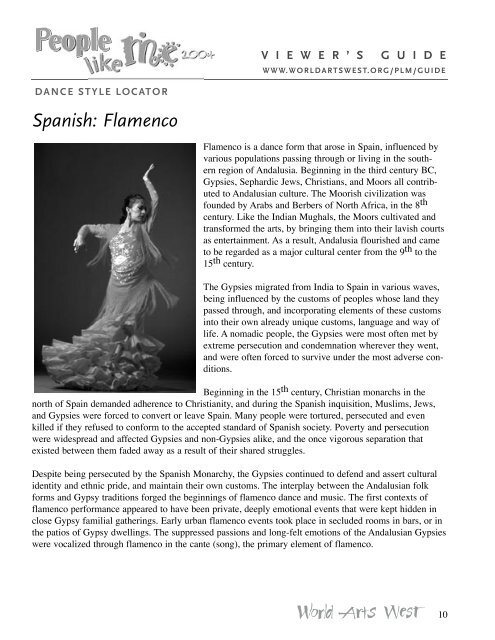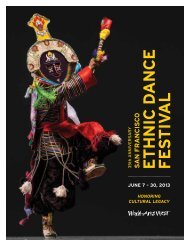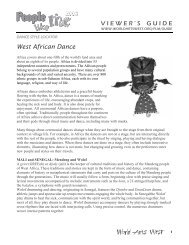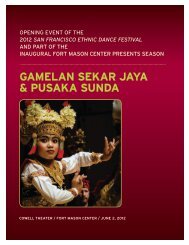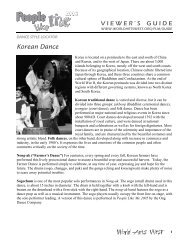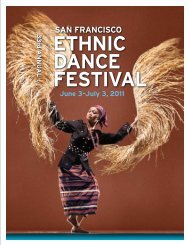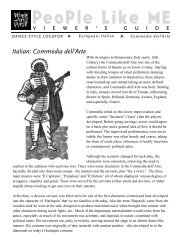South African: Gumboot dance - World Arts West
South African: Gumboot dance - World Arts West
South African: Gumboot dance - World Arts West
You also want an ePaper? Increase the reach of your titles
YUMPU automatically turns print PDFs into web optimized ePapers that Google loves.
V I E W E R ’ S G U I D E<br />
W W W. W O R L D A R T S W E S T. O R G / P L M / G U I D E<br />
DANCE STYLE LOCATOR<br />
Spanish: Flamenco<br />
Flamenco is a <strong>dance</strong> form that arose in Spain, influenced by<br />
various populations passing through or living in the southern<br />
region of Andalusia. Beginning in the third century BC,<br />
Gypsies, Sephardic Jews, Christians, and Moors all contributed<br />
to Andalusian culture. The Moorish civilization was<br />
founded by Arabs and Berbers of North Africa, in the 8 th<br />
century. Like the Indian Mughals, the Moors cultivated and<br />
transformed the arts, by bringing them into their lavish courts<br />
as entertainment. As a result, Andalusia flourished and came<br />
to be regarded as a major cultural center from the 9 th to the<br />
15 th century.<br />
The Gypsies migrated from India to Spain in various waves,<br />
being influenced by the customs of peoples whose land they<br />
passed through, and incorporating elements of these customs<br />
into their own already unique customs, language and way of<br />
life. A nomadic people, the Gypsies were most often met by<br />
extreme persecution and condemnation wherever they went,<br />
and were often forced to survive under the most adverse conditions.<br />
Beginning in the 15 th century, Christian monarchs in the<br />
north of Spain demanded adherence to Christianity, and during the Spanish inquisition, Muslims, Jews,<br />
and Gypsies were forced to convert or leave Spain. Many people were tortured, persecuted and even<br />
killed if they refused to conform to the accepted standard of Spanish society. Poverty and persecution<br />
were widespread and affected Gypsies and non-Gypsies alike, and the once vigorous separation that<br />
existed between them faded away as a result of their shared struggles.<br />
Despite being persecuted by the Spanish Monarchy, the Gypsies continued to defend and assert cultural<br />
identity and ethnic pride, and maintain their own customs. The interplay between the Andalusian folk<br />
forms and Gypsy traditions forged the beginnings of flamenco <strong>dance</strong> and music. The first contexts of<br />
flamenco performance appeared to have been private, deeply emotional events that were kept hidden in<br />
close Gypsy familial gatherings. Early urban flamenco events took place in secluded rooms in bars, or in<br />
the patios of Gypsy dwellings. The suppressed passions and long-felt emotions of the Andalusian Gypsies<br />
were vocalized through flamenco in the cante (song), the primary element of flamenco.<br />
10


